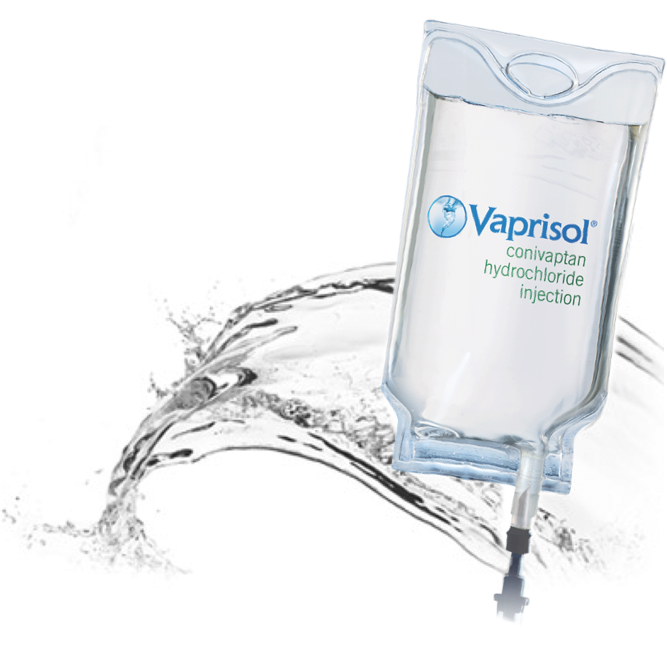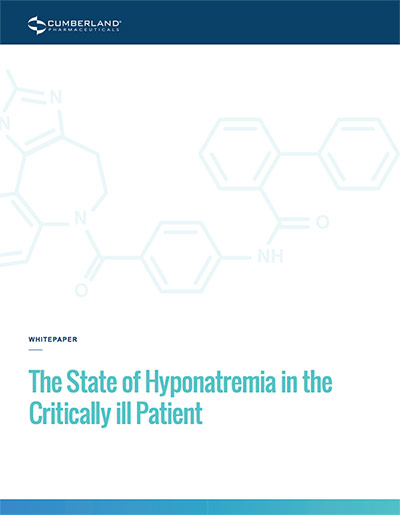
RELIABLE, BALANCED CONTROL
The first and only approved, IV-administered vasopressin receptor antagonist.
Indication: VAPRISOL (conivaptan hydrochloride) injection is indicated to raise serum sodium in hospitalized patients with euvolemic and hypervolemic hyponatremia.
Important Limitations: VAPRISOL has not been shown to be effective for the treatment of the signs and symptoms of heart failure and is not approved for this indication. It has not been established that raising serum sodium with VAPRISOL provides a symptomatic benefit to patients.
(Safety information continued below.)

Day One Response
When treating your hyponatremia patients, consider using Vaprisol. Vaprisol is a dual arginine vasopressin (AVP) antagonist with affinity for human V1a and V2 receptors. Vaprisol raises serum sodium concentration by blocking AVP at the V2 receptor, resulting in free water excretion.1
There are many benefits to using IV treatments such as Vaprisol for patients critically ill with acute hyponatremia. It’s effective day one and has consistency in treatment outcomes.2,3
Plus, it does not require dilution and has a well-defined daily dose (10 mg, 20 mg, or 40 mg).1 Learn how Vaprisol can fit into your practice.
CONTRAINDICATIONS: VAPRISOL is contraindicated in patients with hypovolemic hyponatremia. The coadministration of VAPRISOL with potent CYP3A inhibitors, such as ketoconazole, itraconazole, clarithromycin, ritonavir, and indinavir, is contraindicated. In addition, no benefit can be expected in patients unable to make urine.


Why Use It?
Vaprisol can be used for critically ill patients with acute episodes of hyponatremia. Vaprisol can reliably increase serum sodium in hospitalized patients with euvolemic and hypervolemic hyponatremia. In clinical studies of patients with hyponatremia, Vaprisol significantly increased serum sodium during a 4-day period.1
Learn More About Vaprisol
Discover the benefits of using Vaprisol in acute hyponatremia patients, and keep in touch by signing up to receive our emails. Fill out the form below, and then visit our site to learn more.
REFERENCE:
- VAPRISOL PRESCRIBING INFORMATION. Cumberland Pharmaceuticals Inc. Nashville, TN 2017.
- Palmer BF, Rock AD, Woodward AJ. Dose comparison of conivaptan (Vaprisol®) in patients with euvolemic or hypervolemic hyponatremia – efficacy, safety, and pharmacokinetics. Drug Des Devel Ther. 2016;10:339-51.
- Zeltser D, Rosansky S, van Rensburg H, Verbalis JG, Smith N. Assessment of the efficacy and safety of intravenous conivaptan in euvolemic and hypervolemic hyponatremia. Am J Nephrol. 2007;27(5):447-57.
Important Safety Information and Important Limitations
Vaprisol (conivaptan hydrochloride) Injection
(1) Indication
(2) Important Safety Information
Indication: VAPRISOL is indicated to raise serum sodium in hospitalized patients with euvolemic and hypervolemic hyponatremia.
Important Limitations: VAPRISOL has not been shown to be effective for the treatment of the signs and symptoms of heart failure and is not approved for this indication. It has not been established that raising serum sodium with VAPRISOL provides a symptomatic benefit to patients.
IMPORTANT SAFETY INFORMATION
CONTRAINDICATIONS
VAPRISOL is contraindicated in patients with hypovolemic hyponatremia. The coadministration of VAPRISOL with potent CYP3A inhibitors, such as ketoconazole, itraconazole, clarithromycin, ritonavir, and indinavir, is contraindicated. In addition, no benefit can be expected in patients unable to make urine.
WARNINGS & PRECAUTIONS
Hyponatremia associated with heart failure: Safety data on the use of VAPRISOL in these patients are limited. Consider other treatment options.
Overly rapid correction of serum sodium: Monitor serum sodium, volume and neurologic status and if the patient develops an undesirably rapid rate of rise of serum, VAPRISOL should be discontinued. If serum sodium concentration continues to rise, VAPRISOL should not be resumed. Serious neurologic sequelae, including osmotic demyelination syndrome, can result from over rapid correction of serum sodium. In susceptible patients, including those with severe malnutrition, alcoholism or advanced liver disease, slower rates of correction should be used.
Hypovolemia or Hypotension: For patients who develop hypovolemia or hypotension while receiving VAPRISOL, VAPRISOL should be discontinued, and volume status and vital signs should be monitored.
Infusion site reactions: Serious reactions have occurred. Administer through large veins and change infusion site every 24 hours.
ADVERSE REACTIONS
The most common adverse reactions (incidence ≥10%) are infusion site reactions (including phlebitis), pyrexia, hypokalemia, headache and orthostatic hypotension.
DRUG INTERACTIONS
Potent CYP3A inhibitors may increase the exposure of conivaptan and are contraindicated. Generally avoid CYP3A substrates. Exposure to co-administered digoxin may increase digoxin levels and should be monitored.
USE IN SPECIAL POPULATIONS
Use in Patients with Hepatic Impairment
In patients with moderate to severe hepatic impairment, initiate VAPRISOL with a loading dose of 10 mg over 30 minutes followed by 10 mg/day as a continuous infusion for 2 to 4 days. If no rise in serum sodium, VAPRISOL may be titrated upward to 20 mg/day.
WWW2140517